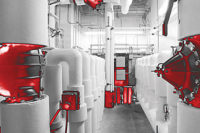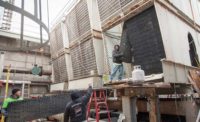Low operating costs are important, but that usually conflicts with the owner’s main goal: limiting initial cost. In the interest of keeping units occupied and renter turnover low, comfort and controllability needn’t be ignored. But you can’t have the best of all worlds. Or can you?
In early 2010, designers at Jarrell Mechanical Contractors devised a successful, all-encompassing solution for a mechanical retrofit at Council Tower apartment building in St. Louis. After careful research and consideration, they settled on a plan to install a single-pipe heating and cooling system.
“Finding a single-pipe solution was the key, but we found an answer during the design process that worked theoretically. The single-pipe mechanical recipe had solved problems at some of our other smaller jobsites, so we focused our attention on that,” said Dewayne Jefferson, P.E., and vice president of engineering at Jarrell Mechanical Contractors.
The multi-phase mechanical system retrofit for the 27-story, 180,000-sq-ft building and its 225 apartments hinged on successful installation of Taco’s LoadMatch single-pipe hydronic system. The LoadMatch-operated pipe network is connected to all terminal fancoil units, an effort that draws to a close later this year.
LESS IS MORE
“Not having to drill new holes through 26 concrete floors was pretty good incentive to give a one-pipe system fair consideration at Council Tower,” said Jefferson, who earned his M.S. in mechanical engineering from the University of Illinois at Urbana-Champaign in 1990. “We saved ourselves the time and hassle of drilling an additional 400 holes.”
Jarrell has 100 service trucks in the greater St. Louis area. With over half a century in the industry, the firm capably handles a wide range of commercial HVAC, plumbing, and sheetmetal work. Although they’re based in Missouri, the firm’s technicians have completed projects as far away as Hawaii, Puerto Rico, Texas, and Washington.
“The original hydronic heating and cooling systems — installed in 1969 when the building was constructed — was a two-pipe changeover system which shared basic supply and return lines to fancoil units,” said Jefferson. “At any given time, the entire building was either in heating or cooling mode. With the two existing floor penetrations — and now with new technology that permits heating or cooling using only two pipes — we’re able to run one heating and one cooling pipe to more than 400 fancoil units without the need to drill new holes.”
Since the old heating and cooling system shared the same pipes, shoulder seasons weren’t comfortable for tenants at Council Tower, especially during those days when the sun was baking the south and west walls of the building. Swapping back and forth from heating to cooling on days with broad temperature swings was out of the question. With an entire building in heating or cooling mode, temperature control within living spaces was largely at the mercy of the building manager’s discretion.
“Tenants were continually calling the maintenance department, complaining about the heating and cooling systems,” said Phil Krull, senior vice president and project manager at E.M. Harris Construction, the general contractor on the project. “Some would call and say it was too hot while others would call, complaining that it was too cold, literally minutes apart.”
“We’ve hired Jarrell as a sub before,” said Krull. “When the bids came in, Jarrell’s looked great. Their experience is hard to beat, too.”
“What we really needed was a system that would be able to efficiently and simultaneously deliver heat to one area of the building and cooling to another,” said Jefferson. “We needed to accomplish this while, at the same time, limiting installation time and cost — these were the deciding factors. The one pipe LoadMatch system really fit the bill.”
The system is the union of two old ideas enhanced by new technology. The old ideas are singlepipe distribution and primary-secondary pumping. The new technology consists of the use of maintenance-free wet rotor circulators. The primary distribution system is a single-pipe loop; the secondary distribution system is a decoupled secondary piping loop for each terminal unit in the system.
Within the system that Jarrell employees installed, wet rotor circulators provide the specified flow to each terminal unit at all times. At Council Tower, 300 cfm fancoils use approximately 2.5 gpm, and the 600 cfm units use 4.5 gpm. Although the Council Tower jobsite is the first time Jarrell has used LoadMatch for air conditioning, they’ve used the system for several heating jobs.
“We were certain we wanted to go with a single-pipe system for this job,” said Jefferson, “When Walt Steiner, president of our manufacturer’s rep firm, Behrmann Company, invited Mike Jarrell and me to tour Taco’s manufacturing facility in Cranston, RI, it reaffirmed our decision.”
“We learned a lot from experts there while on our tour of the facility. A key interest for us was to learn even more about LoadMatch technology,” said Jefferson. “I was surprised to learn just how much the flow of chilled water must increase as it makes its way downstream.”
The temperature difference between the chilled water supply temperature and the entering air temperature decreases as water travels through more fancoil units. Obviously, this decreases the latent, or dehumidification, capacity of the coil. To offset this, as the chilled water supply temperature increases along the system, the flow rate going to the fancoil unit must be increased in order to get the latent capacity out of the coil.
Depending on the capacity curves of the fancoils being used, this increase could be as much as 100% for a given unit size. This increased gpm also causes an increase in pressure drop through the fancoil unit. These two things must be considered to determine whether the individual fancoil unit should be increased in size in order to gain the required latent load, as well as keep the pressure drop to a level that can be easily handled by the LoadMatch pump.
HIGH PERFORMANCE
“We’re keeping an average of eight guys on the job,” continued Jefferson. During phase one, Jarrell’s crew installed a 275-ton Trane chiller on the ground level. Through the use of eight, 3-in. risers and a 25-hp Taco KV vertical inline pump, chilled water is delivered to all the fancoils throughout the building. The chiller is designed for 598 gpm of 40°F water. Outdoor design temp is 95° drybulb, 76° wetbulb.
The heating distribution is almost identical, aside from its much lower volume. Water from two, 1.5 million Btu gas-fired, modulating condensing boilers is piped through eight, 2-in. risers and pressurized with 15-hp pumps. At the outdoor design temp of 0°, each boiler is designed to supply 72 gpm of 160°.
“Both boilers include two separate heat exchangers,” said Jefferson. “Depending upon the building’s heating requirement, this allows for better part load efficiency.”
Using existing floor penetrations, the chilled and hot water lines, both well insulated, run up the building in parallel. Both hot and chilled water lines are equipped with Taco 4900 Series air and dirt separators; 4 in. for the heating side, 6 in. for cooling. The device is equipped with stainless steel “pall” rings and basket assemblies to remove system water micro-bubbles while separating out dirt particles from the flow, easily flushed through a blow-down valve.
“One challenge we faced at the jobsite was keeping the existing systems online as long as possible,” said Steiner. “One remedy was to break the project into four phases.” The first, and by far the lengthiest, phase included installation of the new chiller and boilers. The building was split into four vertical sections. This limited the number of risers that were out of commission at any one time.
The remaining phases will go more quickly, without the large amounts of mechanical equipment to remove and replace. While primary heating or cooling is off to a given area, Jarrell supplied window air conditioning with electric heaters.
Domestic hot water is supplied by two 600-MBtuh boilers that heat a 650-gal storage tank. Two sets of booster pumps located in the basement keep pressure high as the hot water loop heads toward the top floor.
“We have one set of duplex booster pumps for the cold water and a separate set for domestic hot water,” said Jefferson. “All four pumps are 7.5 hp units.”
Since the heating and domestic boilers are both located in the basement, using natural-draft boilers would have been more difficult to install. Getting the flues up and out of the building and having to bring the required combustion air into the mechanical room for the boilers would have proved troublesome. Each high-efficiency boiler used for the heating only required a 6–in. PVC pipe for the flue and a 6-in. PVC pipe for combustion air. The domestic DHW boilers each required 4-in. pipes.
CIRCULATING FOR SUCCESS
The LoadMatch single-pipe system replaces all the control valves and most balancing valves with small, low-kW LoadMatch circulators. The circulators deliver the water to where it needs to go, as opposed to forcing the water to go where it isn’t needed. The savings in raw material, installation costs, and energy consumption are substantial.
The system is self-balancing, reducing many start-up, commissioning, and operational problems because all zones get their required amount of flow at all times.
In addition to the energy savings typical with hydronic systems, the approach reduces head loss by eliminating many control and balancing valves, as well as some pipe. The result is lower pump head and less energy consumption to move the water.
“The Airtherm fancoils being installed are custom made for the job,” said Patrick Taff, president of E.J. Taff Sales Company, Inc., manufacturer’s representative for Airtherm. “LoadMatch pumps can be sweated directly to the pipe, eliminating the large flanges. Without that option, it would have been nearly impossible to get the circulators to fit inside the fancoil cabinets.”
After the engineers at Airtherm did a mock-up, over 800 circulators were shipped to Airtherm’s Arkansas manufacturing facility. Two circulators were installed in each fancoil cabinet, further reducing the amount of on-site piping work needed at the jobsite. Council Tower has only studio and one-bedroom apartments, calling for 300-, 400-, and 600-cfm fancoil units.
“Not only are operating and maintenance costs low, but we’ve found that the LoadMatch system is approximately 10% to 15% less initial cost than a conventional four-pipe system for this type of building,” Jefferson said.
“It won’t be long before all the tenants can move back in,” said Jefferson. “This time around, we’re sure that front desk personnel won’t be plagued with phone calls from irate, uncomfortable tenants. We’re certain they’ll also be happier with their utility bills.” ES






